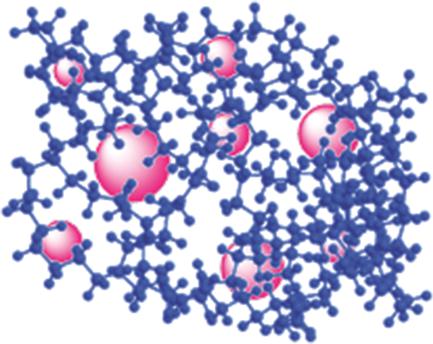当前位置:
X-MOL 学术
›
Macromol. Rapid Commun.
›
论文详情
Our official English website, www.x-mol.net, welcomes your
feedback! (Note: you will need to create a separate account there.)
Enhancement of the Insulation Properties of Poly(2‐oxazoline)‐co‐Polyester Networks by the Addition of Nanofillers
Macromolecular Rapid Communications ( IF 4.2 ) Pub Date : 2018-01-02 , DOI: 10.1002/marc.201700681 Alexander Eibel 1 , Philipp Marx 2, 3 , Huifei Jin 4 , Ioannis-Alexandros Tsekmes 5 , Inge Mühlbacher 1, 2 , Johan J. Smit 4 , Wolfgang Kern 2, 3 , Frank Wiesbrock 2
Macromolecular Rapid Communications ( IF 4.2 ) Pub Date : 2018-01-02 , DOI: 10.1002/marc.201700681 Alexander Eibel 1 , Philipp Marx 2, 3 , Huifei Jin 4 , Ioannis-Alexandros Tsekmes 5 , Inge Mühlbacher 1, 2 , Johan J. Smit 4 , Wolfgang Kern 2, 3 , Frank Wiesbrock 2
Affiliation

|
Copoly(2‐nonyl‐2‐oxazoline)‐stat‐poly(2‐dec‐9′enyl‐2‐oxazoline)s can be crosslinked by the thiol‐ene reaction with glycol dimercaptoacetate. The copoly(2‐oxazoline)‐stat‐copolyester is tested as dielectric for high‐voltage applications, either as unfilled resin or as composite with nanoscaled fillers of silica, alumina, and hexagonal boron nitride. During AC voltage tests, all materials have an average breakdown strength of 45–50 kV mm−1. For DC voltage tests, samples with SiO2 (hBN) have an average breakdown strength of ≈100 (80) kV mm−1, while the unfilled copoly(2‐oxazoline) has an average breakdown strength of ≈60 kV mm−1. Permittivity measurements at 20 °C and 50 Hz reveal that all nanocomposites are dielectrics (D = 0.06–0.08), while the unfilled copoly(2‐oxazoline)s has a high loss factor of D = 8.43. This phenomenon can be retraced to the phase separation in the crosslinked copolymer, the M‐OH functionality of silica and alumina particles, and models of polymer–particle interactions such as the Tanaka model, revealing that the nanofillers reduce the interfacial and dipolar polarizability.
中文翻译:

通过添加纳米填料增强聚(2-恶唑啉)-共聚酯网络的绝缘性能
共聚(2-壬基-2-恶唑啉) - STAT -聚(2-癸9'enyl -2-恶唑啉)类可以通过用乙二醇双巯基的硫醇-烯反应进行交联。共聚(2-恶唑啉) - STAT -copolyester测试作为电介质用于高电压应用中,无论是作为未填充的树脂或作为复合材料的二氧化硅,氧化铝和六方氮化硼纳米尺度填料。在交流电压测试期间,所有材料的平均击穿强度为45–50 kV mm -1。对于直流电压测试,具有SiO 2(hBN)的样品的平均击穿强度为≈100(80)kV mm -1,而未填充的共聚(2-恶唑啉)的平均击穿强度为≈60kV mm -1。在20°C和50 Hz的介电常数测量结果表明,所有纳米复合材料都是电介质(D = 0.06-0.08),而未填充的共聚(2-恶唑啉)具有高损耗因子D = 8.43。这种现象可以追溯到交联共聚物中的相分离,二氧化硅和氧化铝颗粒的M-OH官能度以及诸如Tanaka模型的聚合物-颗粒相互作用模型,这表明纳米填料降低了界面和偶极极化率。
更新日期:2018-01-02
中文翻译:

通过添加纳米填料增强聚(2-恶唑啉)-共聚酯网络的绝缘性能
共聚(2-壬基-2-恶唑啉) - STAT -聚(2-癸9'enyl -2-恶唑啉)类可以通过用乙二醇双巯基的硫醇-烯反应进行交联。共聚(2-恶唑啉) - STAT -copolyester测试作为电介质用于高电压应用中,无论是作为未填充的树脂或作为复合材料的二氧化硅,氧化铝和六方氮化硼纳米尺度填料。在交流电压测试期间,所有材料的平均击穿强度为45–50 kV mm -1。对于直流电压测试,具有SiO 2(hBN)的样品的平均击穿强度为≈100(80)kV mm -1,而未填充的共聚(2-恶唑啉)的平均击穿强度为≈60kV mm -1。在20°C和50 Hz的介电常数测量结果表明,所有纳米复合材料都是电介质(D = 0.06-0.08),而未填充的共聚(2-恶唑啉)具有高损耗因子D = 8.43。这种现象可以追溯到交联共聚物中的相分离,二氧化硅和氧化铝颗粒的M-OH官能度以及诸如Tanaka模型的聚合物-颗粒相互作用模型,这表明纳米填料降低了界面和偶极极化率。











































 京公网安备 11010802027423号
京公网安备 11010802027423号